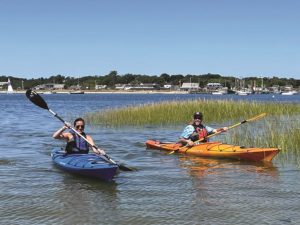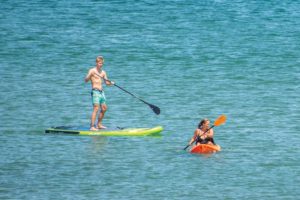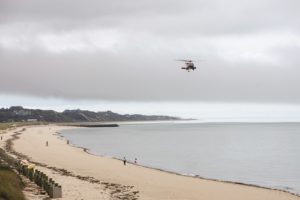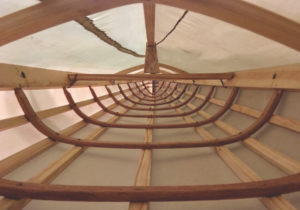I found my used kayak in Deerfield, on the last leg of my drive to Provincetown from my college in Middletown, Conn. After helping me load the scratch-covered boat into the back of my truck, the man selling it to me said, “Cape Cod, huh? Don’t get eaten by a shark,” before patting the kayak’s hull like he was bidding farewell to an old mule.
Wanting to know the best ways to witness the beauty of the Outer Cape from a kayak, I called Mike Schiller, owner of Jack’s Boat Rental in Wellfleet, to ask for recommendations. He told me it was hard to pick favorites.
“There are endless places to paddle,” he said. What makes kayaking on the Outer Cape so good is its combination of freshwater ponds, tidal rivers, and harbors as potential spots to explore. But what’s really special, he said, is the fact that so many are relatively wild yet at the same time accessible.
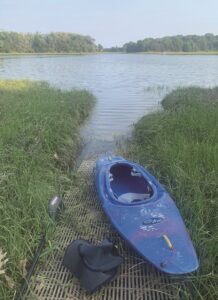
In my first month in Provincetown, I’ve gone on nearly a dozen paddling adventures and not gotten eaten by a shark.
Salt Pond and Nauset Marsh, Eastham, June 11
I began my journey into Salt Pond by carrying my kayak on my shoulder for half a mile in the wrong direction. I can’t say why I took the path that led deep into the woods rather than the one, clearly visible from the parking lot, that led to the pond. After 10 minutes of huffing and puffing in the forest I realized I was lost. I turned around and jogged back — sheepishly emerging from the woods, hoping no one saw me.
The boat landing was swarming with mosquitoes that attacked my shirtless back. I frantically paddled out into the mosquito-less center of the pond and used my paddle as a back scratcher.
A 15-minute paddle across Salt Pond and into the meandering and ever-widening stream took me to Nauset Marsh. No one was out on the water, and the late-afternoon sun spread far across the thousand ridges of the shore. It was close to low tide, and the shallow water was perfectly clear. As I paddled, I saw fish struggling against the tide and crabs crawling on the swirling sand below.
This shallow water is what allows the marsh grasses to take root. The National Park Service describes the marsh as a “full-scale nursery for oceanic fish, shellfish, and microscopic plankton.” Paddling beside these grasses, I could hear a constant rustling.
On the way back, I got stuck on a sandbar. My kayak jutted out of the middle of the bay like a blue boulder. The sun fell behind the trees, a long cold breeze bristled my chest, and a gull cried in the swaying reeds. I was a visitor.
Pamet Harbor and the Pamet River, Truro, June 18
I dropped my boat on the rocky beach of the harbor and paddled away from the bay, through the winding Pamet River. Wispy clouds overhead were reflected on its light brown rippling surface.
Part of the joy of kayaking is how close you are to nature. You sit on its level. I paddled for a bit, then lay back, my head resting on the hull, watching, past the reaching marsh grass, the sky momentarily pierced by birds. I was invisible in my little boat, gliding wakeless on the surface.
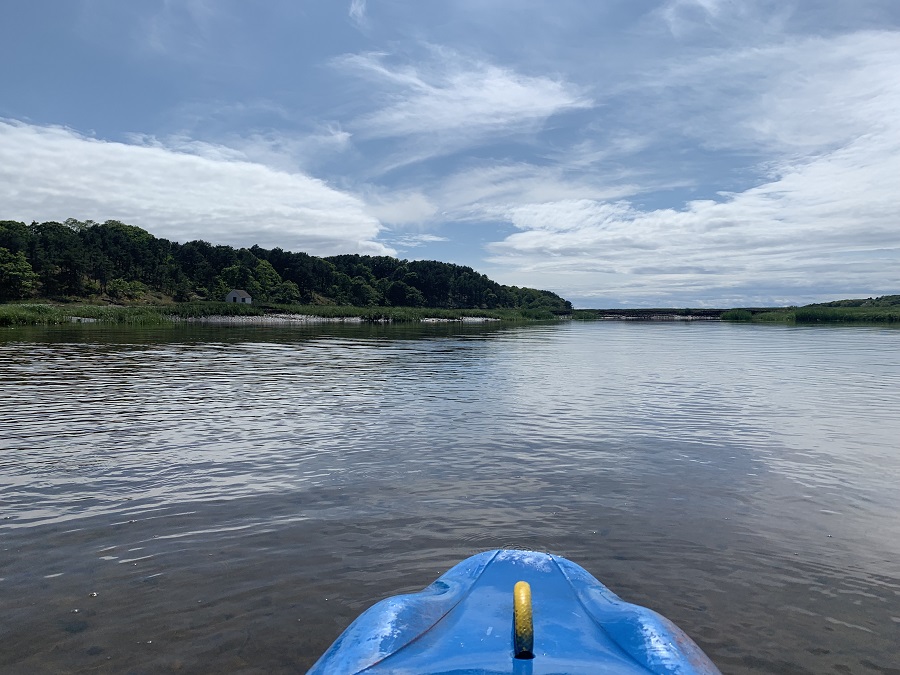
The Pamet River is dotted with marshland that is overrun with fiddler crab burrows, which, stacked up, look like giant mud piles. Paddling up close to their homes was almost frightening. The earth literally rattled with a dancing army of crabs that never stayed still, rotating constantly in and out of the ground.
I paddled back to the harbor and out into the open bay. It was a windy day, and whitecapped waves pounded the shore. I made sure my skirt was tight and paddled hard. I leaned my body back to tilt the kayak up as a wave approached, then swung my body forward at the wave’s peak, landing on the other side with a massive billowing splash. I noticed a few beachgoers taking videos of me. I don’t know if they thought I looked skilled or ridiculous as my dinky kayak fought against the crashing water. A man on the shore filming me gave me a thumbs up. Did he mean “good job” or “are you okay?” I gave a thumbs up back.
Herring Cove Beach, Provincetown, June 19
I scanned the water for a shark fin before paddling out into the calm water off Herring Cove. Unlike my previous trips, which submerged me in solitude of nature, this paddle gave me opportunities to people-watch. I hugged close to the shore and took in views of couples and families lounging on pastel towels, cooking hot dogs, and swimming in the bay.
Three kids competed for who could throw stones the farthest. One boy, wearing a SpongeBob swimsuit, was the undisputed champion and easily could have hit me with a pebble if he had tried. Luckily, he stopped throwing right as I paddled past. The kids waved at me in unison.
I saw two girls trying, without luck, to get a butterfly-shaped kite in the air. Their mother peeked at them from behind her paperback. After a while she got up, hovering by them before opening her palm for the kite’s handle, which they gave her without hesitation. She then ran along the shore, letting the string gently unfurl as the butterfly slowly shrunk against the sky. They were all looking up. They didn’t notice me as I paddled past.

As I continued, the shore grew less and less populated. After about 25 minutes, the people were distant dots over my shoulder. I felt uneasy against the vastness of the ocean as it stretched out to my left. Paddling toward the tidal currents that lead to Race Point Lighthouse, I felt small waves colliding with the kayak from every direction. It was as if the tide, at this sandy edge of the world, had forgotten which way it was supposed to go.
I paddled hard till I made it down a shallow tidal stream leading to the lighthouse. I spotted a man by himself taking pictures of the lonely tower on the elbow of this hook-shaped spit. He looked up from his camera. He hesitated. He waved.
Gull, Higgins, and Williams ponds, Wellfleet, June 21
The Cape’s kettle ponds, according to the National Park Service, were formed by retreating glaciers from the last ice age, over 18,000 years ago. Gull, Higgins, and Williams are three interconnected ponds full of that ancient magic. Paddling through them takes you on a journey back through time.
I started in Gull Pond, which, at nearly 109 acres, is the largest in Wellfleet. It was early afternoon, and there were several paddlers and swimmers out on the near-perfect circle of the pond. I paddled away from its house-lined shore, right across its center, and through the sandy sluiceway that leads to Higgins Pond.
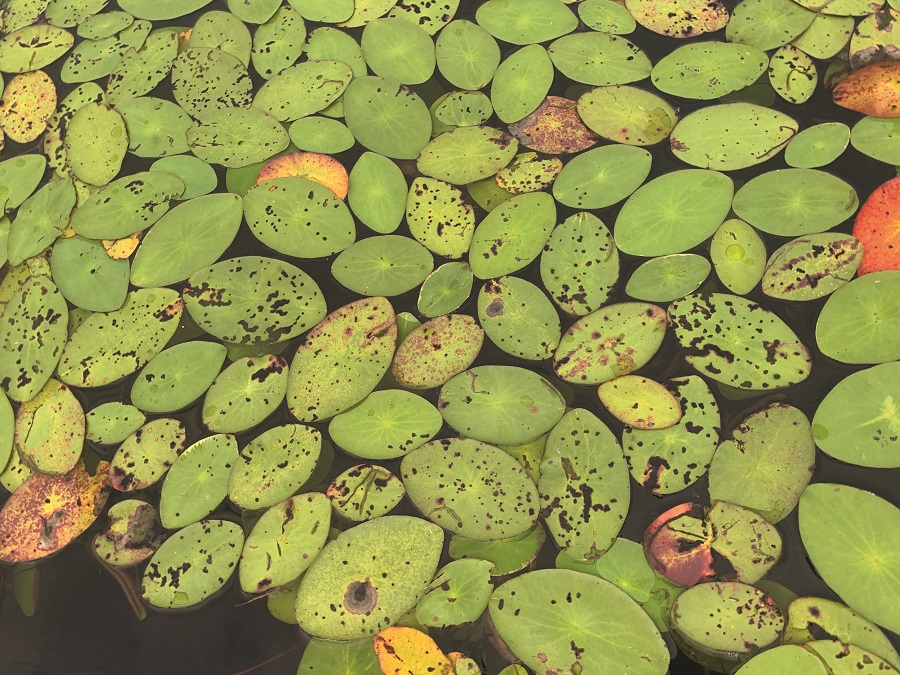
Higgins, about half the size of Gull, has only a few houses on it. It was empty, except for an elderly couple lounging in neon pink beach chairs, fishing from a small spit of sand. The water had a light green hue and a tangled mass of reeds abounded on its borders. Tadpoles swirled around the front of the kayak as I pushed forward.
I had been told there would be another opening to paddle through, so I poked around Higgins’s shore searching for it between the high reeds. After about 10 minutes, I spotted a narrow view into a third pond. I followed this narrow sluiceway, abuzz with honking geese and ribbiting frogs on either side, into Williams Pond.
Williams is tiny. Its surface was entirely covered with lily pads of every shade of green. I saw one faded white house tucked in the corner, as if it had been placed just so to blend in with the environment. I later learned it is famously known as the Wellfleet Oysterman’s House and was visited by Henry David Thoreau in 1849.
These three ponds are like Russian nesting dolls, each having a smaller, more intricate center. There I was, in that ultimate, silent center.
A blue heron swooped low. A yellow flower burst from a lily pad. A distant cormorant called. A pack of geese cut across the darkening sky. One goose trailed behind — he couldn’t keep up. Any minute now, I’d have to paddle home.
